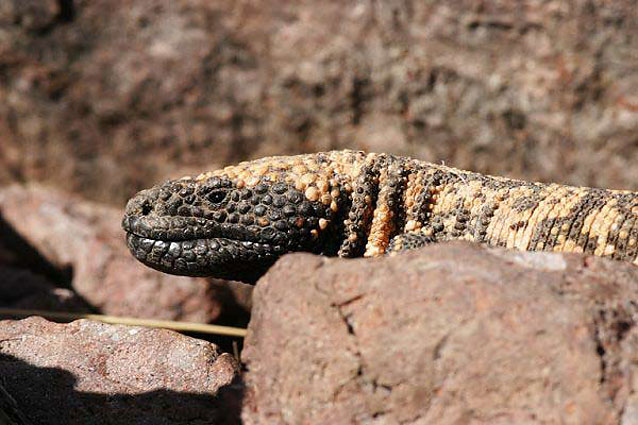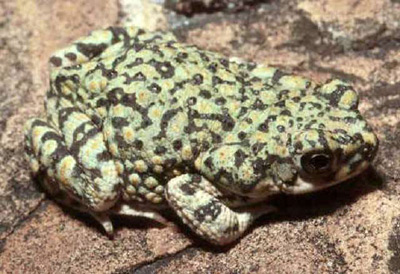Amphibians and reptiles are important components of aquatic and terrestrial ecosystems.
Amphibians constitute an important part of the food web; they consume insects and other invertebrates, and they are prey for a long list of fish, reptile, bird, and mammal species, and even some predatory aquatic insects. Reptiles, too, serve as both predators and prey for many animals, such as small mammals, birds, and other reptiles. The occurrence of amphibians is associated with healthy wetland habitats. Amphibians serve as indicators of ecosystem health, because their permeable skin and complex life histories make them particularly sensitive to environmental disturbance and change.

© Robert Shantz
Amphibians and reptiles are, together, referred to as herpetofauna. Most herpetofauna lay eggs, although some give birth to live young. Amphibians and reptiles are ectotherms, meaning they are unable to regulate heat within their own bodies and must warm up or cool off through behavioral means (e.g., basking in the sun or seeking shade). Although this places limits on their distribution and times of activity, it allows them to live on less energy than mammals or birds of similar sizes. Amphibian and reptile species may occupy similar habitats and are similarly vulnerable to habitat degradation and other threats. Herpetofauna populations may exhibit dramatic, natural fluctuations in site occupancy, distribution, abundance, and species richness.
Distribution and Life History
There are about 460 species of amphibians and reptiles in the continental U.S. (Marks 2006), with a substantial number of species occurring in the American Southwest. The Sonoran Desert supports some 100 reptile and at least 20 amphibian species. The northern region of the Chihuahuan Desert supports more than 170 herpetofauna species. At least 18 species are endemic to the Chihuahuan Desert (e.g., the bolson tortoise [Gopherus flavomarginatus] and Chihuahuan fringe-toed lizard [Uma exsul]), some of which occur in the U.S. Also, the ranges of several lizards are centered in the Chihuahuan Desert (e.g., the Texas banded gecko [Coleonyx brevis] and several species of spiny lizards [Sceloporus spp.]).
There is at least one endemic amphibian in the Southern Colorado Plateau Network (SCPN). The federally endangered Jemez Mountain salamander is the only endemic amphibian in the Colorado Plateau region. It occurs in mixed conifer forests in Bandelier NM and on adjacent US Forest Service lands. The northern leopard frog (Lithobates pipiens), once found throughout Canada and the U.S., has been largely extirpated from much of its former habitat in the southwestern U.S, but still can be found in SCPN parks. The parks within the SCPN support at least 58 herpetofauna species— two salamanders, 11 anurans, 22 lizards, one turtle, and 22 snakes (Persons and Nowak 2006).
An individual park noteworthy because of its large number of herpetofauna species is the Saguaro National Park (SAGU) in the Sonoran Desert Network (SODN). This park is home to 56 native reptile and amphibian species— eight frogs and toads, one salamander, three turtles (including the desert tortoise), and 48 lizards and snakes (including the Gila monster) (Flesch et al. 2006, 2007). This wealth of species is attributed to landscape diversity and the overlap of several major biogeographic provinces, particularly the Sonoran Desert and Madrean mountains of northern Mexico.
Not only are there a large number of herpetofauna species in the Southwest, there are a large number of resources that describe their distribution and life history. Thus, rather than duplicating such material here, we refer readers to some of the many alternative sources (see the last chapter of the series, “Sources of Distribution and Life History Information).” It is not our intent to endorse any particular source.
In addition, herpetofauna surveys have been conducted at many parks in the Southwest. For results of recent inventory projects, see the Reptile and Amphibian projects page of the Science of the American Southwest website. Also see further discussion of inventories in the “Management and Monitoring Activities” chapter of this series. Lists of federally threatened and endangered species at individual parks can be obtained online from NPSpecies.

Colorado Parks and Wildlife
The Greek word “amphibios” means having two lives; the amphibians have a larval stage and an adult stage that are often quite different from one another (e.g., a tadpole and adult frog) (Tyning 1990). However, some amphibians keep many of their larval characteristics, such as external gills, throughout their adult lives. Amphibians take in oxygen and other gases through their glandular skin and the linings of their mouth and throat (they may also have lungs or gills). Like reptiles, amphibians maintain their body temperature by resting in warm or cold places. Most frogs fertilize their eggs externally (with males and females releasing sperm and eggs, respectively, into the water). Salamanders generally show internal fertilization.
Two of the three groups of amphibians, frogs and salamanders, are found in the U.S. The reptiles that inhabit the American Southwest are the snakes, lizards, and turtles. In the Class Reptilia, there are three subclasses. The turtles and tortoises fall within one subclass (in the Order Testudines). The alligators and crocodiles, no members of which occur in the American Southwest, fall within the second subclass (in the Order Crocodylia). The third subclass contains two orders; one (Order Squamata) includes the snakes, lizards, and Amphisbaenians (found in Mexico), and the other (Order Sphenodontia) contains the tuatara (endemic to New Zealand) (Brennan 2008). Reptiles have scales and at least one lung (Tyning 1990). They are ectothermic vertebrates. They have amniotic eggs, which enable them to lay eggs on land. All reptiles reproduce by internal fertilization. Females either lay eggs, keep the eggs within their bodies until they hatch, or give birth to live young, with some form of placentation. Reptiles hatch as miniature versions of the adults.
Prepared by Patricia Valentine-Darby, Southern Plains Network Inventory and Monitoring Program, 2010.
Part of a series of articles titled Reptiles and Amphibians of the American Southwest.
Last updated: May 7, 2015
